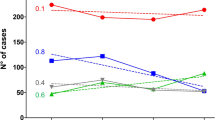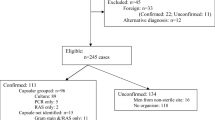Abstract
The present study describes the epidemiology of invasive meningococcal disease (IMD) in Greece for the period 2006–2016. Combined data from notified and laboratory-confirmed IMD cases were obtained from the two involved National Centres (Epidemiology and Reference Laboratory). Laboratory identification and typing was carried out by both conventional (culture) and molecular methods (PCR, MLST, PorA, and FetA typing). A total of 796 IMD cases were notified; of those, 720 (91%) were laboratory confirmed. Overall, a decline on the annual incidence of confirmed cases was observed, ranging from 0.91 (2006) to 0.47 (2016) /100,000. A similar trend was observed in most age groups especially in children 0–4 years (7.7 to 2.9/100,000), with the exception of an increase in the incidence rate in adults > 20 years (0.21 to 0.32/100,000). The overall case fatality rate was 6.5% (52/796), annual range 2–13%. Among 658 strains which were typed by sero/genogroup, 80% were identified as MenB (annual range 65–92%); however, a decline was observed in MenB incidence from 5.3 (2006) to 2.7 (2016), among infants and toddlers, while MenW (1%), MenY (2%), and MenA (1%) remained low. During the 11 years, the annual incidence of IMD declined by 50%, especially in the 0–4-year age group, due mainly to MenB. Continuous surveillance of IMD is important for the development of future vaccination and public health policies.



Similar content being viewed by others
References
Guiddir T, Gros M, Hong E, Terrade A, Denizon M, Deghmane AE, Taha MK (2018) Unusual initial abdominal presentations of invasive meningococcal disease. Clin Infect Dis. https://doi.org/10.1093/cid/ciy257.
Rosenstein NE, Perkins BA, Stephens DS, Popovic T, Hughes JM (2001) Meningococcal disease. N Engl J Med 344(18):1378–1388
Harrison OB, Claus H, Jiang Y, Bennett JS, Bratcher HB, Jolley KA et al (2013) Description and nomenclature of Neisseria meningitidis capsule locus. Emerg Infect Dis J 19:566. https://doi.org/10.3201/eid1904.111799
Kriz P, Wieffer H, Holl K, Rosenlund M, Budhia S, Vyse A (2011) Changing epidemiology of meningococcal disease in Europe from the mid-20th to the early 21st century. Expert Rev Vaccines 10(10):1477–1486
Knuf M, Romain O, Kindler K et al (2013) Immunogenicity and safety of the quadrivalent meningococcal serogroups a, C, W-135 and Y tetanus toxoid conjugate vaccine (MenACWY-TT) in 2-10-year-old children: results of an open, randomised, controlled study. Eur J Pediatr 172(5):601–612
Parikh SR, Newbold L, Slater S, Stella M, Moschioni M et al (2017) Meningococcal serogroup B strain coverage of the multicomponent 4CMenB vaccine with corresponding regional distribution and clinical characteristics in England, Wales, and Northern Ireland, 2007-08 and 2014-15: a qualitative and quantitative assessment. Lancet Infect Dis 17(7):754–762
Whittaker R, Dias JG, Ramliden M, Ködmön C, Economopoulou A, Beer N (2017) Pastore Celentano L; ECDC network members for invasive meningococcal disease. The epidemiology of invasive meningococcal disease in EU/EEA countries, 2004-2014. Vaccine 35(16):2034–2041
Kafetzis DA, Stamboulidis KN, Tzanakaki G, Kourea Kremastinou J, Skevaki CL, Konstantopoulos A, Tsolia M (2007) Meningococcal group C disease in Greece during 1993-2006: the impact of an unofficial single-dose vaccination scheme adopted by most paediatricians. Clin Microbiol Infect 13(5):550–552
Georgakopoulou T, Menegas D, Katsioulis A, Theodoridou M, Kremastinou J, Hadjichristodoulou C (2017) A cross-sectional vaccination coverage study in preschool children attending nurseries-kindergartens: implications on economic crisis effect. Hum Vaccin Immunother 13(1):190–197
Tzanakaki G, Markou F, Kesanopoulos K, Levidiotou S, Pangalis A, Tsolia M et al (2006) Phenotypic assessment of Neisseria meningitidis isolates obtained from patients with invasive meningococcal disease in Greece, 1993-2003: implications for serogroup B vaccines based on PorA serosubtype antigens. Vaccine 24(6):819–825
Tzanakaki G, Tsopanomichalou M, Kesanopoulos K, Matzourani R, Sioumala M, Tabaki A, Kremastinou J (2005) Simultaneous single-tube PCR assay for the detection of Neisseria meningitidis, Haemophilus influenzae type b and Streptococcus pneumoniae. Clin Microbiol Infect 11(5):386–390
Drakopoulou Z, Kesanopoulos K, Sioumala M, Tambaki A, Kremastinou J, Tzanakaki G (2008) Simultaneous single-tube PCR-based assay for the direct identification of the five most common meningococcal serogroups from clinical samples. FEMS Immunol Med Microbiol 53:178
Maiden MC, Bygraves JA, Feil E, Morelli G, Russell JE, Urwin R (1998) Et. al. multilocus sequence typing: a portable approach to the identification of clones within populations of pathogenic microorganisms. Proc Natl Acad Sci U S A 95(6):3140–3145
Russell JE, Jolley KA, Feavers IM, Maiden MC, Suker J (2004) PorA variable regions of Neisseria meningitidis. Emerg Infect Dis 10(4):674–678
Thompson EA, Feavers IM, Maiden MC (2003) Antigenic diversity of meningococcal enterobactin receptor FetA, a vaccine component. Microbiology 149(Pt 7):1849–1858
European Centre for Disease Prevention and Control. Surveillance Atlas for Infectious Diseases. https://atlas.ecdc.europa.eu/public/index.aspx
Pelton SI (2016) The global evolution of meningococcal epidemiology following the introduction of meningococcal vaccines. J Adolesc Health 59(2 Suppl):S3–S11
Sridhar S, Greenwood B, Head C, Plotkin SA, Sáfadi MA, Saha S, Taha MK et al (2015) Global incidence of serogroup B invasive meningococcal disease: a systematic review. Lancet Infect Dis 15(11):1334–1346
Knol MJ, Hahné SJM, Lucidarme J, Campbell H, de Melker HE, Gray SJ, Borrow R et al (2017t) Temporal associations between national outbreaks of meningococcal serogroup W and C disease in the Netherlands and England: an observational cohort study. Lancet Public Health 2(10):e473–e482
Ladhani SN, Beebeejaun K, Lucidarme J, Campbell H, Gray S, Kaczmarski E, Ramsay ME, Borrow R (2015) Increase in endemic Neisseria meningitidis capsular group W sequence type 11 complex associated with severe invasive disease in England and Wales. Clin Infect Dis 60(4):578–585
Krone M, Gray S, Abad R, Skoczyńska A, Stefanelli P, van der Ende A, Tzanakaki G et al (2019) Increase of invasive meningococcal serogroup W disease in Europe, 2013 to 2017. Euro Surveill 24(14):1800245. https://doi.org/10.2807/1560-7917.ES.2019.24.14.1800245
Bröker M, Emonet S, Fazio C, Jacobsson S, Koliou M, Kuusi M et al (2015) Meningococcal serogroup Y disease in Europe: continuation of high importance in some European regions in 2013. Hum Vaccin Immunother 11(9):2281–2286. https://doi.org/10.1080/21645515.2015.1051276.
Parikh SR, Campbell H, Gray SJ, Beebeejaun K, Ribeiro S, Borrow R, Ramsay ME, Ladhani SN (2018) Epidemiology, clinical presentation, risk factors, intensive care admission and outcomes of invasive meningococcal disease in England, 2010-2015. Vaccine 36(26):3876–3881
Abad R, Medina V, Stella M, Boccadifuoco G, Comanducci M, Bambini S, Muzzi A, Vázquez JA (2016) Predicted strain coverage of a new meningococcal multicomponent vaccine (4CMenB) in Spain: analysis of the differences with other European countries. PLoS One 11(3):e0150721
Tzanakaki G, Hong E, Kesanopoulos K, Xirogianni A, Bambini S, Orlandi L, Comanducci M, Muzzi A, Taha MK (2014) Diversity of Greek meningococcal serogroup B isolates and estimated coverage of the 4CMenB meningococcal vaccine. BMC Microbiol 14:111. https://doi.org/10.1186/1471-2180-14-111
Kremastinou J, Tzanakaki G, Kansouzidou A, Pagalis A, Danielides V, Kouppari G et al (1999) Recent emergence of serogroup C meningococcal disease in Greece. FEMS Immunol Med Microbiol 23(1):49–55
Bukovski S, Vacca P, Anselmo A, Knezovic I, Fazio C, Neri A et al (2016) Molecular characterization of a collection of Neisseria meningitidis isolates from Croatia, June 2009 to January 2014. J Med Microbiol 65(9):1013–1019
Jandova Z, Musilek M, Vackova Z, Kozakova J, Krizova P (2016) Serogroup and clonal characterization of Czech invasive Neisseria meningitidis strains isolated from 1971 to 2015. PLoS One 11(12):e0167762
Parent du Chatelet I, Deghmane AE, Antona D, Hong E, Fonteneau L, Taha MK, Lévy-Bruhl D (2017 Jun) Characteristics and changes in invasive meningococcal disease epidemiology in France, 2006-2015. J Inf Secur 74(6):564–574. https://doi.org/10.1016/j.jinf.2017.02.011
Vacca P, Fazio C, Neri A, Ambrosio L, Palmieri A, Stefanelli P (2018) Neisseria meningitidis antimicrobial resistance in Italy, 2006 to 2016. AAC 62:9
Acknowledgments
The authors would like to thank Prof Aftab Jasir for critical reviewing and colleagues from hospitals all over Greece for sending samples.
Partial data have been presented previously at the ESCAIDE 2018-European Scientific Conference on Applied Infectious Disease Epidemiology (Malta, 21–23 Nov 2018).
Author information
Authors and Affiliations
Consortia
Contributions
Anastasia Flountzi (AF) analysis and interpretation of data, drafting of manuscript. Theano Georgakopoulou (TG) acquisition of data, analysis and interpretation of data, critical revision. Sooria Balasegaram (SB) analysis and interpretation of data, drafting of manuscript. Konstantinos Kesanopoulos (KK) acquisition of data. Athanasia Xirogianni (AX) acquisition of data. Anastasia Papandreou (AP) acquisition of data. Georgina Tzanakaki (GT) study conception and design, acquisition of data, critical revision.
Corresponding author
Ethics declarations
Ethics statements
Ethic approval was not required since depersonalized data from notifiable disease registry and laboratory findings were used.
Conflict of interest
The authors declare that they have no conflict of interest.
Additional information
Publisher’s note
Springer Nature remains neutral with regard to jurisdictional claims in published maps and institutional affiliations.
Rights and permissions
About this article
Cite this article
Flountzi, A., Georgakopoulou, T., Balasegaram, S. et al. Epidemiology of invasive meningococcal disease in Greece, 2006–2016. Eur J Clin Microbiol Infect Dis 38, 2197–2203 (2019). https://doi.org/10.1007/s10096-019-03668-y
Received:
Accepted:
Published:
Issue Date:
DOI: https://doi.org/10.1007/s10096-019-03668-y




